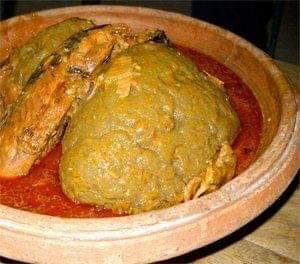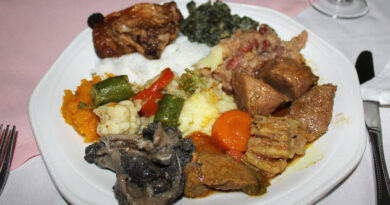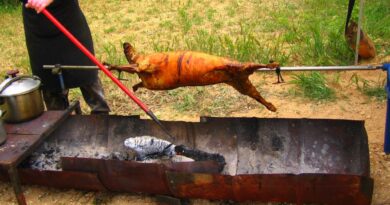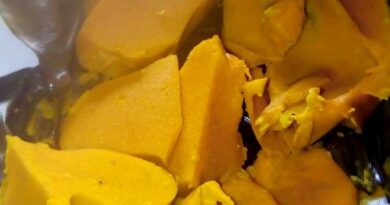Konkonte
Konkonte: A Nutritional Powerhouse and Culinary Gem of Ghana
Introduction
Ghanaian cuisine is a vibrant tapestry of flavors, ingredients, and culinary traditions that reflect the rich cultural heritage of its people. Among the many traditional dishes that have been passed down through generations, Konkonte stands out for its simplicity, nutritional value, and cultural significance. Known colloquially as “Face the Wall” due to its humble appearance, Konkonte is a dish made from dried and pounded cassava flour. This article will explore the origins, preparation methods, cultural significance, and various ways to enjoy this quintessential Ghanaian dish.
The Origins of Konkonte
Konkonte, also referred to as “Lafun” in Nigeria and “Kokonte” in some parts of Ghana, has deep historical roots in West Africa. The primary ingredient, cassava, was introduced to the region by Portuguese traders in the 16th century and quickly became a staple due to its adaptability to different climates and soil types. Cassava is known for its resilience and ability to thrive in conditions where other crops might fail, making it a reliable source of nutrition.
In Ghana, cassava is a major food crop, and its versatility allows it to be used in various forms, such as fufu, gari, and tapioca. Konkonte, however, involves drying the cassava, pounding it into flour, and rehydrating and cooking it. This method of preparation not only extends the shelf life of cassava but also makes it an accessible and affordable food option for many Ghanaians.
The Preparation of Konkonte
Making Konkonte is straightforward but requires attention to detail to achieve the desired consistency and flavor. Here’s a comprehensive guide to preparing this traditional dish:
Ingredients
- Cassava flour: 2 cups (either freshly prepared or store-bought)
- Water: 4-5 cups
- Salt: to taste (optional)
Preparation Steps
- Preparing Cassava Flour: If you are using fresh cassava, the first step involves peeling and washing the cassava roots thoroughly. Cut the cassava into small pieces and spread them to dry under the sun for several days until they become hard and brittle. Once dried, pound the cassava pieces into fine flour using a mortar, pestle, or grinding machine. Store-bought cassava flour is also available for convenience.
- Mixing the Flour and Water: Bring the water to a boil in a large saucepan. Gradually add the cassava flour to the boiling water while stirring continuously to prevent lumps from forming. The mixture will begin to thicken as the flour absorbs the water.
- Cooking the mixture: Reduce the heat to low and stir vigorously. The consistency should be thick and smooth, similar to mashed potatoes. If the mixture becomes too thick, add a little more water to achieve the desired consistency. Add salt to taste, if desired.
- Simmering and Serving: Cover the saucepan and let the mixture simmer for about 10–15 minutes, stirring occasionally to prevent it from sticking to the bottom. Once fully cooked, the Konkonte should have a firm yet smooth texture. Serve it hot, accompanied by soups, stews, or sauces.
Cultural Significance of Konkonte
Konkonte is more than just a dish; it is a symbol of resilience and resourcefulness in Ghanaian culture. During times of economic hardship or food scarcity, Konkonte has served as a reliable and affordable source of sustenance. Its long shelf life and ease of preparation make it an essential part of the diet, especially in rural areas where cassava is abundantly grown.
In many Ghanaian households, Konkonte is enjoyed as a staple food, often paired with a variety of soups and stews. It is particularly popular in the Ashanti and Brong-Ahafo regions, where it is often prepared for family meals, communal gatherings, and traditional ceremonies. The dish’s simplicity and nutritional value make it a beloved comfort food that brings people together.
Nutritional Value of Konkonte
Konkonte is a highly nutritious dish that provides essential carbohydrates, which are the primary source of energy for the body. Cassava, the main ingredient, is rich in dietary fiber, which aids in digestion and helps maintain a healthy gut. It also contains important vitamins and minerals such as vitamin C, calcium, and potassium.
While cassava itself is low in protein, the dish is typically served with protein-rich soups and stews made from meat, fish, or legumes, making it a balanced and wholesome meal. The combination of cassava and accompanying dishes ensures that the nutritional needs of individuals are met, especially in communities where other food sources may be limited.
Variations of Konkonte
Though the basic recipe for Konkonte remains consistent, several regional and individual variations reflect the diversity of Ghanaian cuisine. These variations often incorporate different ingredients and cooking techniques to enhance the dish’s flavor and nutritional value.
Konkonte with Groundnut Soup
One of the most popular ways to enjoy Konkonte is with groundnut (peanut) soup. This rich and flavorful soup is made from ground peanuts, tomatoes, onions, and a variety of spices. Meat or fish is often added to the soup for extra protein. The combination of Konkonte and groundnut soup is a classic pairing that highlights the complementary textures and flavors of the two dishes.
Konkonte with Light Soup
Light soup, also known as “Nkrakra,” is another common accompaniment for Konkonte. This soup is typically made from tomatoes, onions, and a variety of meats or fish. It has a lighter consistency compared to groundnut soup and is often seasoned with fresh herbs and spices. The subtle flavors of light soup make it an ideal match for the earthy taste of Konkonte.
Konkonte with Palm Nut Soup
Palm nut soup, or “Abenkwan,” is a hearty and aromatic soup made from palm fruit extract, tomatoes, and spices. It is often cooked with meat, fish, or snails. The rich and savory flavor of palm nut soup pairs perfectly with the mild taste of Konkonte, creating a satisfying and wholesome meal.
Konkonte in Popular Culture
Konkonte has a significant presence in Ghanaian popular culture. It is frequently mentioned in songs, movies, and literature as a symbol of traditional values and resilience. The dish’s humble origins and nutritional value have made it a subject of pride and nostalgia for many Ghanaians.
In recent years, there has been a renewed interest in traditional foods like Konkonte, driven by a growing awareness of the importance of preserving cultural heritage and promoting healthy eating. Food bloggers, chefs, and culinary enthusiasts are increasingly featuring Konkonte in their recipes and social media posts, showcasing its versatility and appeal to a broader audience.
The Joy of Making and Sharing Konkonte
For many Ghanaians, the process of making and sharing Konkonte is a communal activity that brings people together. The preparation of the dish often involves multiple steps that require cooperation and coordination, fostering a sense of community and togetherness.
Elders in the community play a crucial role in passing down the knowledge and techniques for making Konkonte to younger generations. This transmission of culinary skills ensures that the tradition of making Konkonte continues to thrive, preserving an important aspect of Ghanaian cultural heritage.
Modern Twists on Konkonte
While the traditional preparation of Konkonte remains popular, modern twists on the dish have emerged, reflecting changing tastes and culinary innovations. Some contemporary chefs and home cooks have experimented with incorporating different ingredients and flavors to create new and exciting versions of Konkonte.
Konkonte Fries
A modern twist on the traditional dish is Konkonte fries. By cutting cooked Konkonte into sticks and frying them until crispy, you create a delicious and innovative snack that can be enjoyed on its own or with a variety of dips. This version appeals to both traditionalists and those looking for a new way to enjoy this classic dish.
Flavored Konkonte
Adding different spices and herbs to the Konkonte mixture before cooking can create unique and flavorful variations. Ingredients such as garlic, ginger, or chili can enhance the dish’s taste and add an extra layer of complexity. This approach allows for personalization and creativity while maintaining the core elements of the dish.
Konkonte with Vegetable Stews
For a vegetarian twist, Konkonte can be served with hearty vegetable stews. Ingredients like spinach, tomatoes, eggplant, and mushrooms can be used to create rich and flavorful stews that complement the mild taste of Konkonte. This variation is not only nutritious but also accommodates different dietary preferences.
Conclusion
Konkonte is a dish that embodies the rich culinary heritage and cultural resilience of Ghana. From its humble origins as a staple food during times of scarcity to its status as a beloved comfort food, Konkonte has remained a significant part of Ghanaian cuisine. Its preparation is a testament to the resourcefulness and ingenuity of the people who have passed down this tradition through generations.
Whether enjoyed in its traditional form or through modern interpretations, Konkonte continues to be a versatile and nutritious dish that brings people together. Its presence in popular culture and the renewed interest in traditional foods highlight its enduring appeal and importance. As more people discover and appreciate the unique flavors and cultural significance of Konkonte, its legacy will continue to thrive, connecting the past with the present and future.



